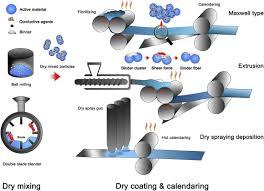Dry Battery Electrode Market Overview Highlights Growth, Applications, and Innovations

The global dry battery electrode market is rapidly transforming the way batteries are manufactured and deployed across industries. With growing pressure to reduce environmental impact and improve production efficiency, manufacturers are turning to dry electrode technologies as a sustainable and cost-effective alternative to traditional wet-coated methods. By eliminating solvents and shortening the production process, dry battery electrodes are not only greener but also ideal for next-generation energy storage applications such as electric vehicles (EVs), consumer electronics, and grid storage. This market overview explores the key elements shaping the sector’s current landscape and future outlook.
1. What Are Dry Battery Electrodes?
Dry battery electrodes refer to electrode materials applied onto current collectors without the use of liquid solvents. Unlike the conventional wet coating method, which requires drying and solvent recovery, dry electrode manufacturing uses dry powder and compression techniques. This results in faster processing, lower energy consumption, and a cleaner production environment.
Key benefits include:
-
Elimination of toxic solvents like NMP
-
Reduction in production time and cost
-
Higher energy density in final battery cells
-
Better environmental and workplace safety
These advantages are making dry electrodes an attractive solution for industries prioritizing performance and sustainability.
2. Market Dynamics and Growth Drivers
Several dynamic factors are driving the expansion of the dry battery electrode market:
-
Rising EV Adoption: Automakers are increasingly integrating dry electrodes to reduce battery weight and production costs, thereby improving electric vehicle performance.
-
Sustainable Manufacturing Trends: Regulatory bodies and consumers are pushing for cleaner production methods, making dry electrode technology an environmentally responsible choice.
-
Technological Advancements: R&D is improving dry electrode compatibility with new materials like silicon anodes and solid electrolytes, unlocking greater battery performance.
-
Cost Reduction Pressures: The simplified production process of dry electrodes translates to lower manufacturing expenses, making them appealing to battery producers aiming for scalability.
3. Applications Across Key Industries
Dry battery electrodes are finding increasing adoption across various sectors, including:
-
Electric Vehicles (EVs): Lightweight and high-density battery packs enabled by dry electrodes enhance driving range and charging speed.
-
Consumer Electronics: Smartphones, laptops, and wearable devices benefit from the compact and efficient nature of dry-coated batteries.
-
Grid Energy Storage: As renewable energy becomes mainstream, utilities are investing in long-duration storage systems supported by dry electrode-based batteries.
-
Industrial Tools and Robotics: Portability and high-power output are crucial in this space, where dry electrodes offer clear advantages.
4. Regional Market Insights
North America:
The U.S. is leading the adoption of dry electrode technologies through government-supported clean energy initiatives and growing EV manufacturing. Companies are investing in domestic battery plants equipped with dry processing lines.
Europe:
The region’s strong focus on sustainability and electric mobility is fueling demand for dry electrodes. Germany and Scandinavia are prominent players in battery innovation and dry technology adoption.
Asia-Pacific:
Home to battery manufacturing giants like China, Japan, and South Korea, this region dominates global production. Asian firms are scaling up dry electrode integration to maintain their competitive edge in EV and electronics markets.
5. Competitive Landscape and Key Players
The dry battery electrode market is becoming increasingly competitive, featuring established players and innovative startups:
-
Tesla has been vocal about integrating dry electrode technology in its future battery lines.
-
Panasonic and LG Energy Solution are investing in dry processing R&D to improve manufacturing efficiency.
-
Startups like 24M Technologies are developing proprietary dry coating methods that appeal to large-scale manufacturers.
These players are focusing on intellectual property, automation, and collaborations to expand their market footprint.
6. Challenges and Considerations
Despite its promise, dry electrode technology faces several hurdles:
-
Scale-Up Challenges: Moving from pilot lines to mass production requires significant investment and process optimization.
-
Material Compatibility: Not all electrode materials work well with dry processing, requiring ongoing material innovation.
-
Cost of Transition: Existing manufacturing lines may need extensive retooling to adopt dry processes, presenting a barrier for some producers.
However, continued investment and technological progress are expected to overcome these limitations.
7. Future Outlook
The dry battery electrode market is expected to experience robust growth over the next decade. As demand for high-efficiency, low-impact battery production increases, dry electrode technology will play a pivotal role. Future trends include:
-
Integration with solid-state batteries
-
Automation of dry coating processes
-
Development of recyclable and biodegradable electrode materials
-
Government and private sector investment in green energy storage solutions
Conclusion
The dry battery electrode market is reshaping the battery industry by offering a cleaner, faster, and more efficient method of electrode production. From automotive giants to energy storage providers, stakeholders across the energy ecosystem are embracing this transformative technology. As innovations continue and scalability improves, dry electrodes are poised to become a cornerstone in the global shift toward sustainable energy and advanced battery systems.
- Art
- Causes
- Crafts
- Dance
- Drinks
- Film
- Fitness
- Food
- Games
- Gardening
- Health
- Home
- Literature
- Music
- Networking
- Other
- Party
- Religion
- Shopping
- Sports
- Theater
- Wellness


